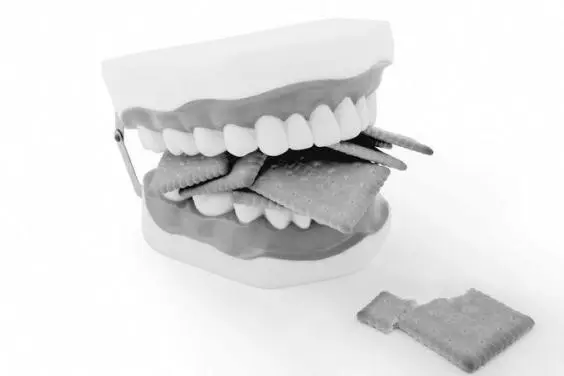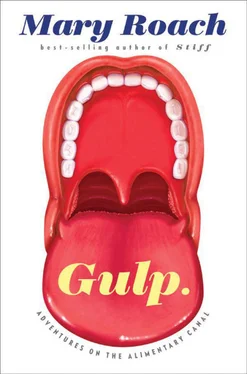The comparison was especially apt in the summer of 2005, when a small-scale Chinese operation was caught using human hair instead of soy to make cheap ersatz soy sauce. Our hair is as much as 14 percent L-cysteine, an amino acid commonly used to make meat flavorings and to elasticize dough in commercial baking. How commonly? Enough to merit debate among scholars of Jewish dietary law, or kashrut. “Human hair, while not particularly appetizing, is Kosher,” states Rabbi Zushe Blech, the author of Kosher Food Production , on Kashrut.com “There is no ‘guck’ factor,” Blech maintained, in an e-mail. Dissolving hair in hydrochloric acid, which creates the L-cysteine, renders it unrecognizable and sterile. The rabbis’ primary concern had not to do with hygiene but with idol worship. “It seems that women would grow a full head of hair and then shave it off and offer it to the idol,” wrote Blech. Shrine attendants in India have been known to surreptitiously collect the hair and sell it to wigmakers, and some in kashrut circles worried they might also be selling it to L-cysteine [25] The other common source of L-cysteine is feathers. Blech has a theory that this might explain the medicinal value of chicken soup, a recipe for which can be found in the Gemorah (shabbos 145b) portion of the Talmud. L-cysteine, he says, is similar to the mucus-thinning drug acetylcysteine. And it is found, albeit in lesser amounts, in birds’ skin. “Chicken soup and its L-cysteine,” Blech said merrily, may indeed be “just what the doctor ordered.”
producers. This proved not to be the case. “The hair used in the process comes exclusively from local barber shops,” Blech assures us. Phew.
• • •
THE MOST EFFECTIVE agent of dietary change is the adulated eater—the king who embraces whelks, the revolutionary hero with a passion for skewered hearts. “Normally disgusting substances or objects that are associated with admired… persons cease to be disgusting and may become pleasant,” writes Paul Rozin. For organ meats today, that person has been taking the form of celebrity chefs at high-profile eateries, such as Los Angeles’s Animal and London’s St. John, and on Food Network programs. On the Iron Chef episode “Battle Offal,” judges swooned over raw heart tartar, lamb’s liver truffles, tripe, sweetbreads, and gizzard. If things go as they usually go, hearts and sweetbreads might start to show up on home dinner tables in five or ten years.
Time and again, AFB’s Pat Moeller has watched the progression with ethnic cuisines: from upscale restaurant to local eatery to dinner table to supermarket freezer section. “It starts as an appetizer typically. That’s low risk. Then it migrates to an entrée dish. Then it becomes a food that you can buy and take home and fix for your family.”
With organ meats, where the prep may include, say, “removal of membrane,” the last phase will be slow-going. Unlike filets and stewing meats, organs look like what they are: body parts. That’s another reason we resist them. “Organs,” says Rozin, “remind us of what we have in common with animals.” In the same way a corpse spawns thoughts of mortality, tongues and tripe send an unwelcome message: you too are an organism, a chewing, digesting sack of guts.
To eat liver, knowing that you, too, have a liver, brushes up against the cannibalism taboo. The closer we are to a species, emotionally or phylogenetically, the more potent our horror at the prospect of tucking in, the more butchery feels like murder. Pets and primates, wrote Mead, come under the category “unthinkable to eat.” The same cultures that eat monkey meat have traditionally drawn the line at apes.
The Inuit, at the time I visited Igloolik, had no tradition of keeping animals as companions. A sled dog was more or less a piece of equipment. When I told Makabe Nartok that I had a cat, he asked, “What do you use it for?” In America, pets are family, never fare. That feeling held fast even during the years of World War II rationing, when horse or rabbit—delicacies right over the pond in France—might, you’d think, have seemed preferable to organs. In the 1943 opinion piece “Jackrabbit Should Be Used to Ease Meat Shortage,” Kansas City scientist B. Ashton Keith bemoans the “wasted meat resource” of jackrabbit carcasses that were being left for coyotes and crows after being killed by ranchers in “great drives that slaughter thousands.” (Most of these seemingly collected by Keith’s mother: “Some of the pleasantest recollections of my boyhood are of fried jackrabbit, baked jackrabbit, jackrabbit stew, and jackrabbit pie.”)
SELF-MADE “NUTRITIONAL ECONOMIST” Horace Fletcher espoused a singular approach to getting Americans through a wartime meat shortage without resorting to rationing, or jackrabbits. What Fletcher proposed was a simple if burdensome adjustment to the human machinery.
4. The Longest Meal
CAN THOROUGH CHEWING LOWER THE NATIONAL DEBT?


THE HORACE FLETCHER papers reside in a single cardboard box of a size that would hold a lightweight cardigan. The self-dubbed economic nutritionist did not attend Harvard, [26] He did, however, leave the residue of his estate to Harvard, part of which went toward funding the Horace Fletcher Prize. This was to be awarded each year for “the best thesis on the subject ‘Special Uses of Circumvallate Papilli and the Saliva of the Mouth in Regulating Physiological Economy in Nutrition.’” Harvard’s Prize Office has no record of anyone applying for, much less winning, the prize.
but it is Harvard that came to own his letters, now stored in some dim recess of the Houghton Library. It was a spring day in May when I visited them. Outside the open windows, a run-through of commencement was under way, speeches being delivered before a plain of empty chairs. I recall feeling relieved by the compactness of the collection, for it appeared it could be gone through in a couple of hours, leaving time to enjoy the warm, chlorophyll-brightened Cambridge afternoon.
The box was deceptive. Fletcher had typed on the thinnest of onion-skin typing paper. As the years wore on, his margins grew smaller and smaller, often disappearing entirely. Fletcher was an efficiency buff, and his obsession appears to have carried over to his habits as a letter writer. Just as he believed in extracting the most nourishment possible from a mouthful of food, he sought to extract the maximum use from each sheet of stationery. Around 1913, he switched from double- to single-spacing and began typing on both sides of the page. Because the paper was thin to the point of transparency, Fletcher’s words bled through, causing some of the missives, though typed, to be practically illegible.
What I am getting at is that there is a point at which efficiency crosses over into lunacy, and the savings in money or resources cease to be worthwhile in light of the price paid in other ways. Horace Fletcher danced around that point his whole career. What amazes me is the degree to which he was taken seriously.
Fletcher was the instigator of a fad for extremely thorough chewing. We are not talking about British Prime Minister William Gladstone’s thirty-two chews per bite. We are talking about this: “One-fifth of an ounce of the midway section of the young garden onion, sometimes called ‘challot,’ has required seven hundred and twenty-two mastications before disappearing through involuntary swallowing.” (More on chewing and the “oral device” in chapter 7.)
Читать дальше














